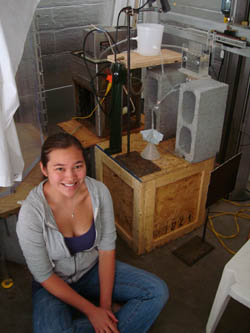Heard From
Laura Timms, Graduate Student
I spent the summer at the labs as one of the NSF/Blinks/Beacon fellows working with Dr. Danny Grünbaum in Oceanography. Coming from Texas A&M University, where I work on annelid phylogenetics, I went to the Friday Harbor labs hoping to learn more about the research process. I was eager to design an experiment and act as PI of a study. Upon arriving at the labs, I began looking into the biomechanics of larvae, specifically the early swimming mechanism.
Planktonic larval phases are common in marine taxa, and typically function as the pelagic dispersal form. Recent evidence suggests that early development of active swimming may play a crucial role in larval survival. Marine environments are highly variable in the vertical direction, so vertical swimming is likely to be an important performance variable for early-stage larvae. However, vertical swimming requires an effective mechanism for orientation. The relatively simple external morphology of most early-stage larvae, and their lack of internal sensory structures, suggest that they orient through a passive gravitational mechanism, i.e., by having a center of buoyancy anterior to their center of gravity. This mechanism could depend strongly on a morphological feature seen in many early-stage larvae: an anterior blastocoel.
We hypothesized that larvae are able to manipulate their blastocoel density by preferentially transporting ions in or out, and that the blastocoel plays a crucial role in oriented swimming. This hypothesis implies that changing the salinity of the seawater would require compensating changes in blastocoel characteristics to maintain directed swimming. For example, in fresher water the blastocoel would be enlarged to maintain buoyancy. To test the effects of salinity on early-stage larval blastocoels, we reared Dendraster excentricus larvae at higher and lower salinities and measured their blastocoels at three pre-pluteus stages. We used our measurements in hydrodynamic models of early swimming across a range of blastocoel densities. Our results indicated a significant difference in blastocoel size between treatments, with larger blastocoels developing in lower salinity. The model results suggested that blastocoel geometry and density have important consequences for swimming performance rates, indicating biomechanical constraints on early-stage larvae across a broad range of taxa.
Since my summer at Friday Harbor, I have returned to Texas A&M University and am completing my senior thesis project on the phylogeography of sipunculid worms. I continue to work with Danny on modeling larval swimming. I hope to attend graduate school, eventually earning my Ph.D..
Laura Timms
Graduate Student
Texas A&M University
NSF Blinks / Beacon Fellow

